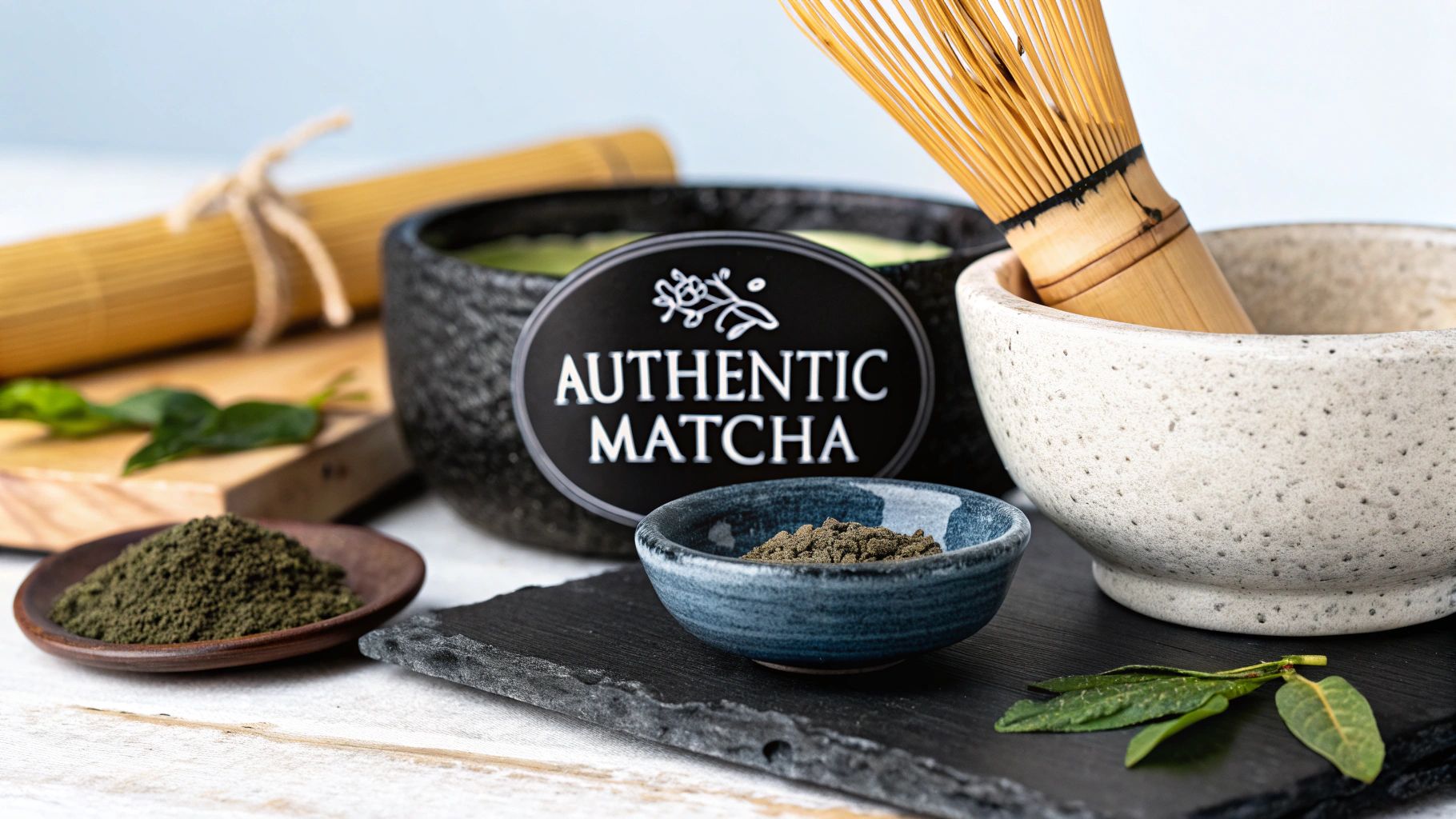Let's delve into the world of authentic matcha, that vibrant green powder with a history deeply rooted in Japanese tradition. This guide is all about looking past the trendy café lattes to understand what makes genuine matcha powder from japan the absolute gold standard for focused energy and holistic wellness.
The Enduring Allure of Japanese Matcha
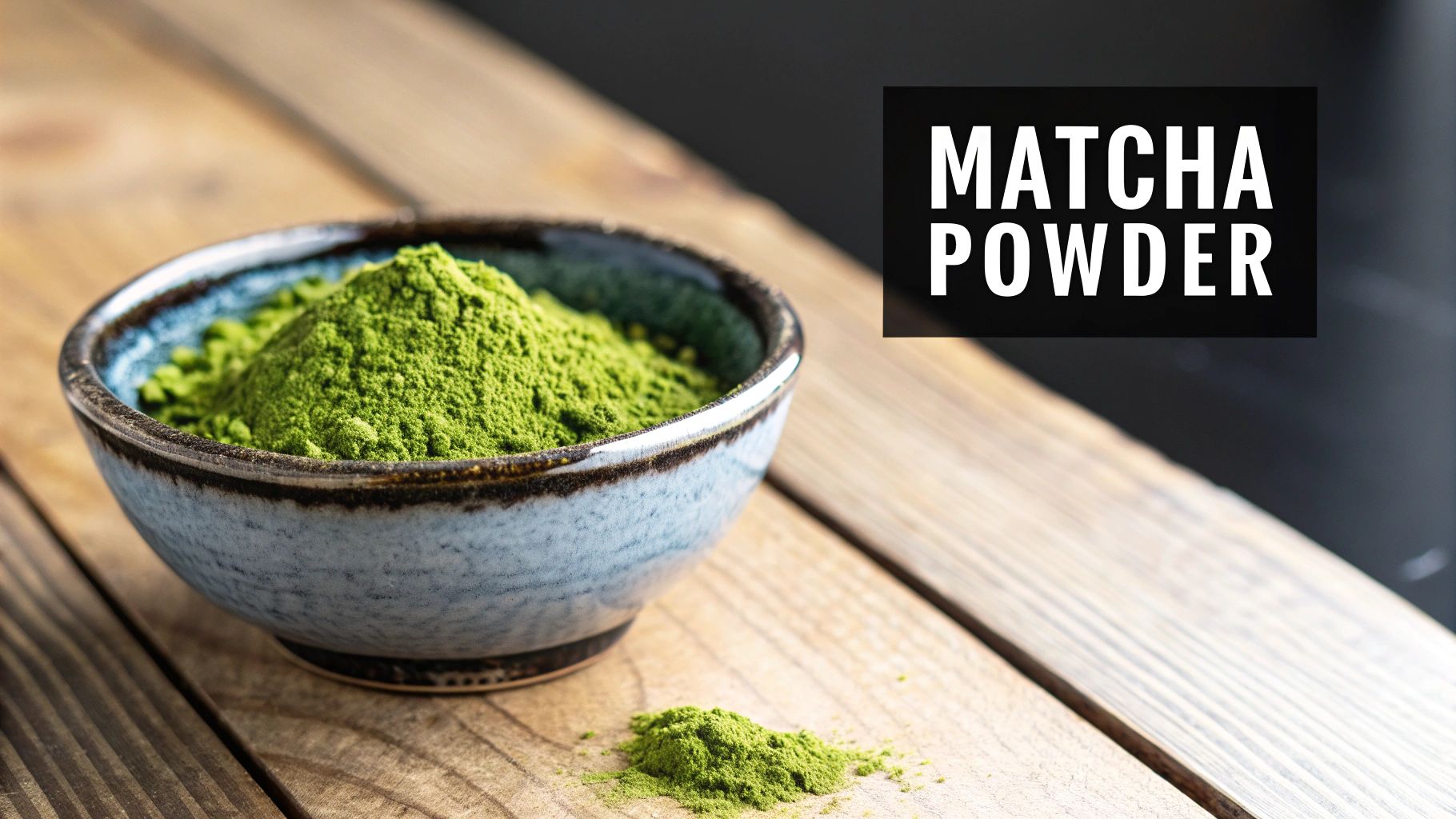
Matcha isn't just a drink; it's a cultural icon, a wellness ritual, and a full sensory experience rolled into one. When you drink regular green tea, you're just steeping the leaves and then tossing them. With matcha, you’re consuming the entire leaf, which has been carefully stone-ground into the finest of powders.
This whole-leaf approach is a game-changer. It means you get 100% of the leaf’s nutrients, including a powerful hit of antioxidants and the amino acid L-theanine. This is the magic behind matcha's signature "calm alertness"—a state of focused energy without the jittery side effects you might get from coffee. It's the feeling Amatsu Matcha's Pure blend is designed to deliver.
A Tradition of Mindful Preparation
The very act of preparing matcha is a form of meditation. Historically, Zen Buddhist monks relied on matcha to stay alert yet peaceful during long meditation sessions, a mindful practice that has been perfected over centuries.
At its heart, preparing and savouring matcha is an invitation to slow down. It’s a moment of intentional calm in a fast-paced world, connecting you to a practice that has been cherished for nearly a thousand years.
This rich history is infused into every single bowl. The traditional Japanese tea ceremony, known as chado or "the way of tea," elevates this simple preparation into a stunning art form. To get a better sense of its deep cultural significance, have a look at our guide to the traditional Japanese tea ceremony.
Why Origin Matters So Much
While the word "matcha" is now used globally, its soul is undeniably Japanese. The country’s unique blend of climate, soil, and generations of farming expertise creates a product that simply can't be replicated anywhere else. Regions like Uji, just outside Kyoto, are legendary for producing the most exceptional matcha leaves in the world.
This guide will walk you through everything you need to know:
- The meticulous cultivation methods that define real, authentic matcha.
- How to spot high-quality matcha and steer clear of lower-grade imitations.
- The incredible health benefits linked to genuine Japanese matcha.
- Simple techniques to master the art of preparing the perfect bowl at home.
Think of this as your complete journey into appreciating and enjoying matcha powder from japan just as it was always meant to be.
What Makes Real Matcha Powder from Japan So Special?
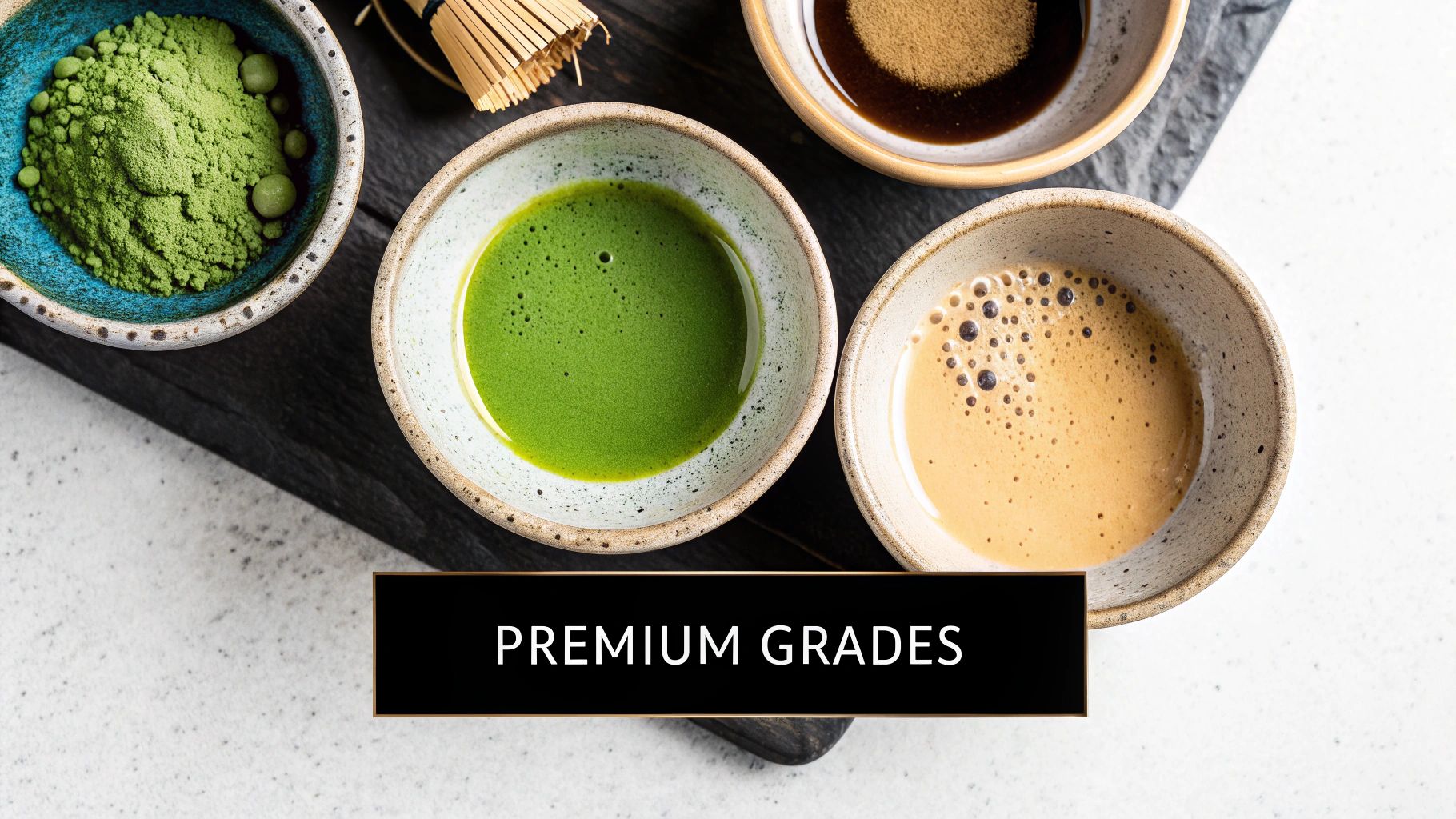
Let's be clear: not all green powders are matcha. True matcha powder from Japan is a bit like Champagne—its name is a protected promise of origin and meticulous quality. Everything else is just sparkling wine.
This difference comes down to a non-negotiable process, a series of traditional techniques honed over centuries that simply can't be rushed or faked. Understanding this journey from leaf to powder is the key to appreciating why authentic matcha from brands like Amatsu Matcha delivers an experience like no other.
The Art of Shade-Growing
The magic begins weeks before the harvest. For about 20-30 days, the tea plants (Camellia sinensis) are carefully shielded from direct sunlight under bamboo mats or purpose-built tarps. This isn't just for show; it's a crucial step that fundamentally changes the leaf.
This deliberate stress forces the plant to go into overdrive, producing huge amounts of chlorophyll. This is what gives authentic matcha its signature, almost electric, green colour. More importantly, it ramps up the production of amino acids, especially L-theanine—the compound responsible for matcha's famous ability to calm the mind while also giving it a deep, savoury umami flavour.
Shading isn’t just a farming technique; it's the foundational step that sets matcha apart from every other green tea. It rewires the leaf’s chemistry, creating that unique balance of calm alertness and rich flavour that matcha is celebrated for.
If you skipped this step, you'd end up with a tea full of bitter-tasting catechins, much like standard green tea.
A Meticulous Harvest
Once the shaded leaves, now called tencha, are ready, only the absolute best are chosen for high-grade matcha. The harvest is a painstaking affair. Skilled farmers hand-pick only the youngest, greenest, and most tender leaves right from the top of the plant.
These young leaves are prized for their natural sweetness, higher nutrient content, and soft texture. This incredibly selective process ensures the final powder is silky smooth and full of flavour, without any of the bitterness you get from older, tougher leaves or stems. It's a world away from mass-market teas where machines indiscriminately chop everything down.
Steaming to Lock in Goodness
Immediately after picking—often within hours—the delicate tencha leaves are briefly steamed. This is a critical moment in the process for a few key reasons:
- It Halts Oxidation: The steam instantly stops the enzymes that would otherwise cause the leaves to wilt and turn brown, just like a cut apple left on the counter.
- It Preserves Colour and Nutrients: By stopping oxidation in its tracks, steaming locks in that vibrant green colour and the leaf's rich supply of vitamins, minerals, and antioxidants.
- It Protects the Flavour: This quick blast of steam is essential for maintaining the fresh, grassy, and subtly sweet notes that define top-quality matcha.
After steaming, the leaves are gently dried. At this point, they're still whole leaves. The final, most transformative step is yet to come.
The Slow Grind to Perfection
The defining final stage is grinding the dried tencha leaves into an impossibly fine powder. True artisanal matcha powder from Japan is ground using traditional granite stone mills, known as ishiusu. This is where patience really comes into play.
The process is incredibly slow and deliberate. A single stone mill might take a full hour just to produce around 30-40 grams of matcha. This gentle grinding generates almost no heat, which is vital for protecting the tea's delicate aromas and flavour compounds.
Industrial metal grinders, by contrast, create too much friction and heat. This essentially "burns" the tea, resulting in a dull, yellowish powder with a harsh, bitter taste. The traditional stone-grinding method creates a powder with a particle size of just 5-10 microns—finer than smoke. This is what allows it to dissolve so beautifully in water, creating that signature creamy, frothy texture we all love.
You can learn more about the deep connection between traditional methods and final quality in our guide to organic matcha from Japan.
Decoding Ceremonial and Culinary Matcha Grades
Stepping into the world of matcha powder from Japan can feel a little confusing at first, but it all becomes much clearer once you understand the two main grades: Ceremonial and Culinary. This isn't a simple case of 'good' versus 'bad'. Instead, it's about matching the right powder to the right purpose for the best possible flavour and experience.
A great way to think about it is like olive oil. You have that exquisite, cold-pressed extra virgin oil you’d only ever drizzle over a fresh salad to appreciate its delicate, peppery notes. Then you have your everyday olive oil, which is perfect for cooking and frying. Matcha works on a very similar principle.
This chart gives you a quick visual on some of the key nutritional differences, comparing things like antioxidants, caffeine, and L-theanine.
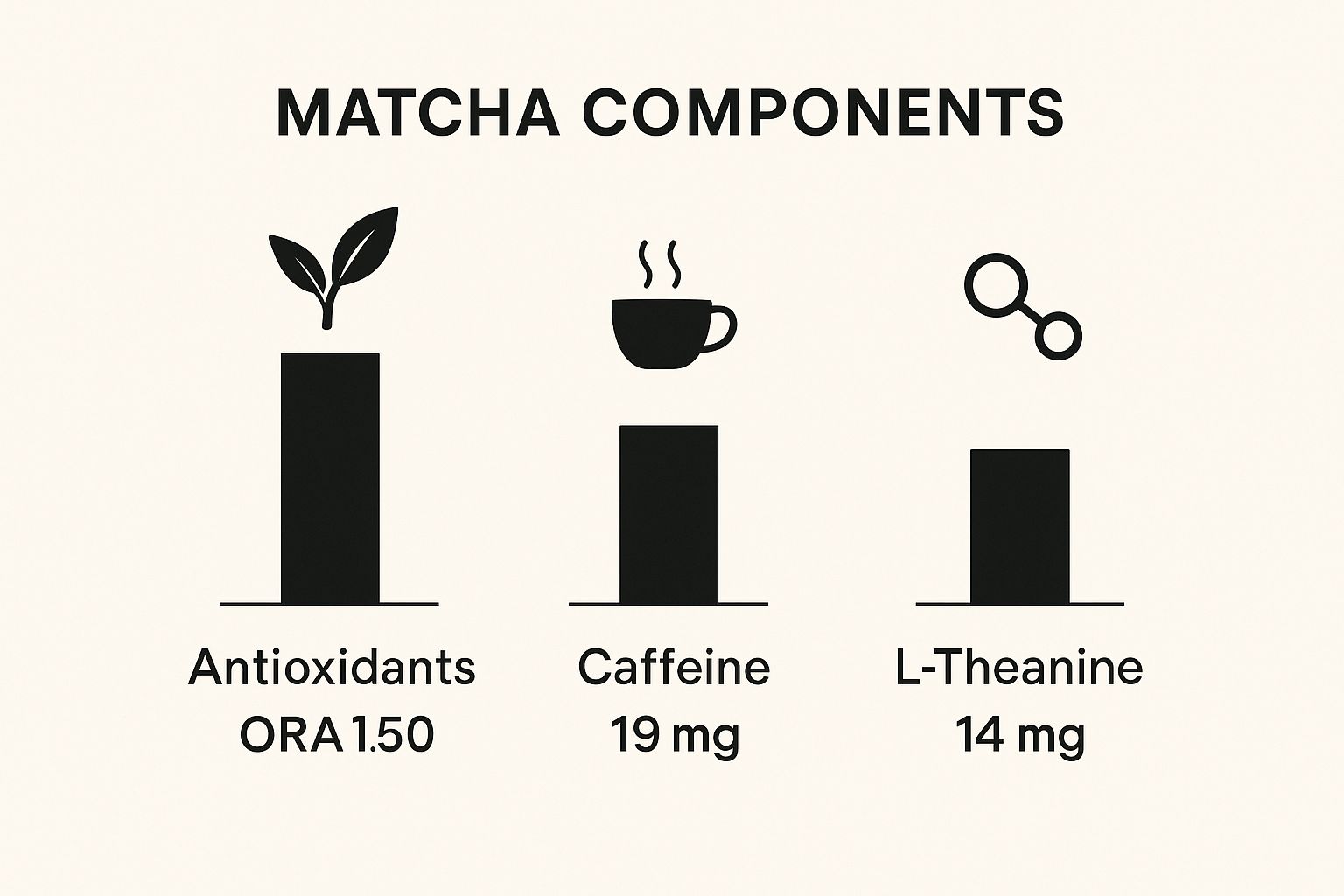
As you can see, the meticulous process behind Ceremonial grade matcha gives it a more concentrated profile of these beneficial compounds, which is why it's so prized for drinking straight.
The Essence of Ceremonial Grade Matcha
Ceremonial grade is truly the cream of the crop. It's crafted exclusively from the youngest, most tender tea leaves plucked during the very first harvest of the year, known as ichibancha.
These precious leaves are shade-grown for weeks before picking, a process that floods them with chlorophyll and the amino acid L-theanine. This is what gives Ceremonial matcha its stunningly vibrant green colour, its natural sweetness, and that deep, savoury flavour we call umami.
After harvesting, the leaves are stone-ground into a powder so fine it feels like silk. It’s designed specifically for the traditional Japanese tea ceremony, where it’s simply whisked with hot water. Amatsu Matcha's Pure blend is a perfect example of this grade, delivering a pure, authentic taste. Its flavour is so nuanced and complex that you wouldn't want to add anything else—milk or sugar would completely mask its beautiful character.
This is the matcha you drink to appreciate matcha itself. It's an experience meant to be savoured purely, allowing its subtle sweetness and profound umami notes to take centre stage.
The Power of Culinary Grade Matcha
Now, let's look at Culinary grade matcha. This powder comes from leaves picked in later harvests. Because these leaves are a bit older and have seen more sunlight, they develop a bolder, more assertive flavour that can be slightly more astringent.
But this isn't a drawback—it's its greatest strength. That robust character is exactly what you need when you're mixing matcha with other ingredients. It’s designed to shine through, not get lost in the crowd.
It’s the go-to for:
- Matcha Lattes: Its strong flavour profile holds its own against the creaminess of milk.
- Smoothies: It adds a wonderful, earthy depth that pairs beautifully with fruits and greens.
- Baking: It infuses cakes, biscuits, and ice cream with that unmistakable matcha taste and colour.
Because it's made from later harvests, culinary grade is also more affordable, which makes it the perfect, practical choice for getting creative in the kitchen every day. To dive even deeper, check out our complete guide to the different grades of matcha tea.
Ceremonial vs Culinary Matcha At a Glance
To make it even simpler, here’s a straightforward comparison of the two grades. Think of this as your cheat sheet for choosing the perfect matcha for any occasion.
| Attribute | Ceremonial Grade Matcha | Culinary Grade Matcha |
|---|---|---|
| Harvest Time | First harvest (Ichibancha) | Second, third, and later harvests |
| Colour | Vibrant, electric green | Muted, often yellowish-green |
| Texture | Ultra-fine, silky powder | Coarser, more fibrous powder |
| Flavour Profile | Sweet, delicate, rich in umami | Bold, robust, slightly bitter |
| Best For | Drinking straight with water (usucha/koicha) | Lattes, smoothies, baking, and cooking |
| Price Point | Higher | More affordable |
Ultimately, having both grades in your cupboard is the best way to go. You’ll have the exquisite Ceremonial grade for those quiet moments of pure tea enjoyment, and the versatile Culinary grade ready for all your delicious kitchen experiments.
Unlocking the Health Benefits of Japanese Matcha
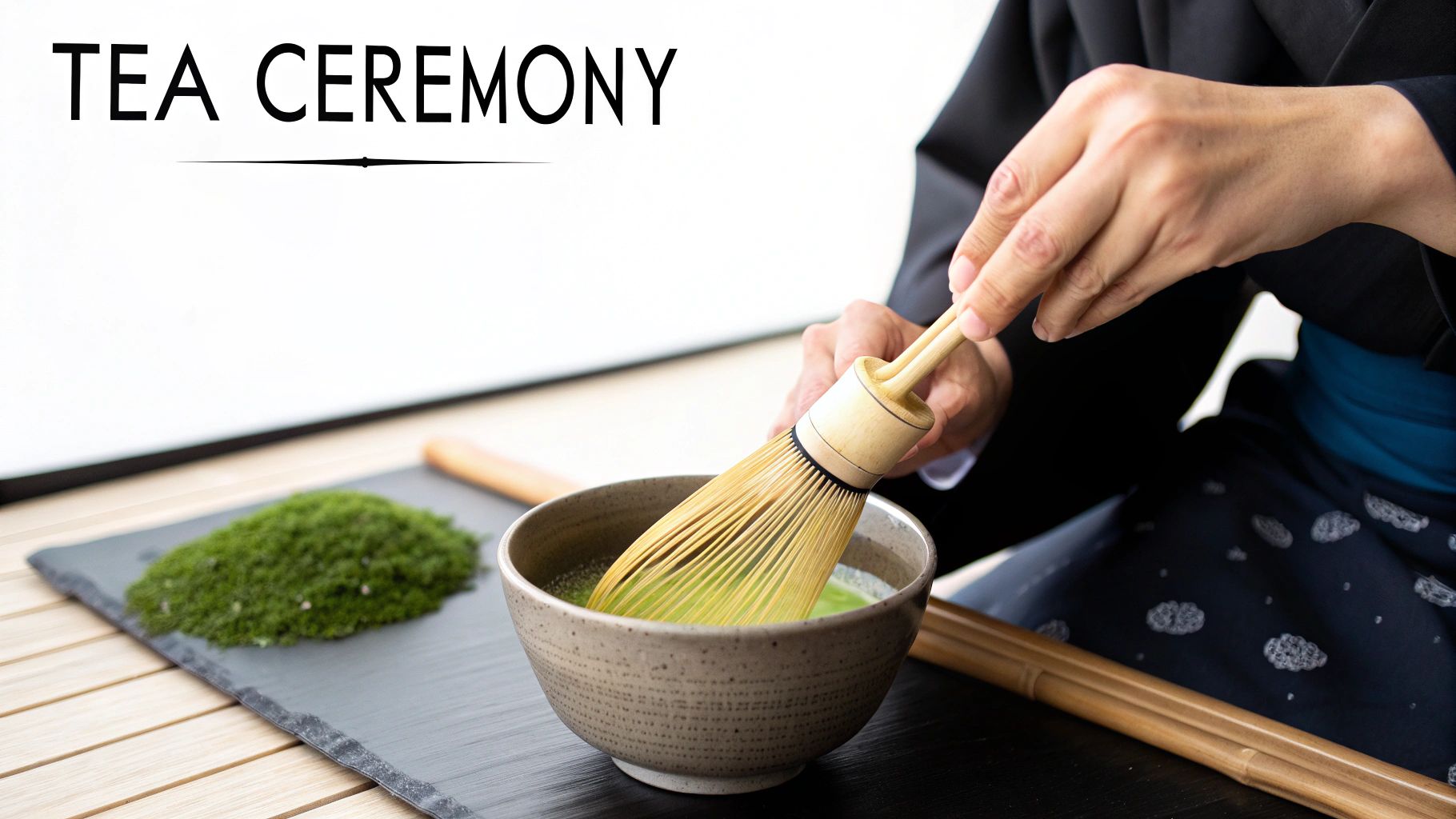
There's so much more to authentic matcha powder from Japan than its beautiful, vibrant colour. It’s earned its reputation as a wellness powerhouse for a very good reason, and it all comes down to how it's grown and prepared. Unlike other teas where you just steep the leaves, with matcha, you consume the entire leaf. This simple difference unlocks a concentrated dose of nutrients you just can't get from steeping alone.
This whole-leaf approach is precisely what makes matcha a true superfood. Every single serving is brimming with a potent blend of vitamins, minerals, and phytonutrients that work in harmony to support both your mind and body. It’s why Amatsu Matcha created functional blends like Radiance with collagen, Shrooms with adaptogenic mushrooms, and Strength with added protein.
A Rich Source of Potent Antioxidants
One of the standout benefits of Japanese matcha is its incredibly high concentration of antioxidants. It’s particularly packed with a class of antioxidants called catechins, and the most powerful and abundant of these is epigallocatechin gallate (EGCG).
Think of antioxidants as your body's personal defence force. They work tirelessly to neutralise harmful free radicals—unstable molecules that wreak havoc on our cells, causing damage, inflammation, and contributing to the ageing process. The special shade-growing method used for matcha dramatically increases its EGCG content, making it a far more potent source than your standard cup of green tea.
This remarkable antioxidant profile is a huge reason for matcha's growing popularity. In fact, the UK matcha tea market is forecasted to grow at an 8.3% compound annual growth rate from 2025 to 2030, with matcha powder itself commanding over 55% of market revenue. This surge is directly tied to a growing awareness of its health benefits, including an antioxidant level said to be 137 times higher than regular green tea. You can explore more about this trend in the full market analysis.
Calm, Focused Energy Without the Jitters
Many people are swapping their coffee for matcha, and for good reason. It provides a unique kind of energy, thanks to a beautiful synergy between two key compounds: caffeine and the amino acid L-theanine. While matcha certainly contains caffeine, the L-theanine cleverly counteracts the jitters and anxiety often associated with it.
L-theanine encourages the production of alpha waves in the brain, which are linked to a state of relaxed alertness. It’s that feeling of being completely "in the zone"—calm, focused, and present, but without any nervous energy or the dreaded caffeine crash later on.
This unique chemical pairing is matcha's secret weapon. The caffeine provides the boost, while the L-theanine ensures that energy is smooth, sustained, and focused. The result is a state of tranquil alertness that can last for hours.
This makes matcha the perfect companion for a productive work session, a creative project, or any time you need to sharpen your mental performance without feeling overwhelmed.
Enhancing Cognitive Function and Metabolism
The benefits of the caffeine and L-theanine combination go beyond just mood and energy. Studies suggest this dynamic duo can also improve cognitive functions like memory, attention, and reaction time. The compounds work together to enhance brain performance, making it easier to stay sharp and on task.
On top of that, the powerful EGCG in matcha has been linked to boosting metabolism. This specific catechin may help increase the rate at which your body burns calories, making matcha a great supportive element in a balanced diet and active lifestyle.
By bringing high-quality matcha powder from Japan into your daily routine, you aren’t just enjoying a delicious tea; you're tapping into a centuries-old tradition of holistic wellness. For a deeper dive into these advantages, you can learn more about the specific health benefits of matcha powder in our comprehensive article. Each sip offers a powerful blend of antioxidants, calm energy, and cognitive support, truly nurturing your mind and body from the inside out.
Choosing and Storing Your Matcha Like a Pro
Walking into the world of Japanese matcha powder is exciting, but knowing how to pick a good one can feel a bit daunting at first. It helps to remember that not all green powders are the same. A few simple checks can be the difference between a truly special experience and a disappointing one.
Think of it like choosing a fine wine or artisanal coffee. The best matcha delivers a complex, rewarding taste, while a lower-quality powder will just taste flat and bitter. If you plan on drinking it traditionally (just with water), paying attention to these details is what really counts.
What to Look for When Buying Matcha
When you’re holding a tin of matcha, your senses are your best friend. Three things will tell you almost everything you need to know about its quality: colour, aroma, and texture. These are direct clues about how fresh the tea is and the care that went into growing and grinding it.
Here’s what you should be looking for:
- Colour: You want a vibrant, almost electric green. That brilliant hue comes from the careful shade-growing process, which ramps up the chlorophyll in the leaves. If it looks dull, yellowish, or brownish, that’s a red flag for older leaves or poor storage.
- Aroma: Pop open the tin and take a good sniff. Top-tier matcha should smell fresh, sweet, and vegetal, with a hint of that savoury umami. If it smells dusty, like old hay, or has almost no scent at all, it's probably stale.
- Texture: The powder itself should feel incredibly fine and silky, almost like talcum powder. This super-fine consistency is the hallmark of traditional stone grinding. It should feel smooth between your fingers, not coarse or gritty.
The surest sign of quality? Its origin. Always check that your matcha comes directly from Japan. Regions like Uji (in Kyoto) and Nishio (in Aichi) are legendary for producing some of the world's finest ceremonial-grade teas.
How to Properly Store Your Matcha
So, you’ve brought home a beautiful tin of matcha. Now what? Keeping it fresh is absolutely key to enjoying it. Matcha is delicate stuff, and it has three major enemies: light, air, and heat. All three will quickly zap its colour, flavour, and health benefits.
Proper storage isn't difficult, but you have to be disciplined about it. Once opened, matcha is best enjoyed within a few months to really appreciate it at its peak.
To protect your investment, just follow these simple steps:
- Keep it Airtight: Always, always store your matcha in an airtight container. The tin it comes in is usually perfect for this. Oxygen is the enemy of freshness, causing the powder to oxidise, which dulls its flavour and vibrancy.
- Keep it Cool: Once you’ve opened it, the fridge is your matcha’s best friend. The cool temperature dramatically slows down the degradation process. Just make sure the lid is on tight—you don't want your tea absorbing the aroma of last night's leftovers.
- Keep it Dark: Light is one of the fastest ways to ruin good matcha. Never store it in a clear jar or leave it out on the worktop. The original tin or another opaque container is the way to go to protect that gorgeous green colour.
Preparing the Perfect Bowl of Matcha at Home
Making a brilliant bowl of matcha powder from Japan at home isn't about complicated steps; it's a simple, mindful ritual that's incredibly satisfying. It’s a chance to turn a few basic ingredients into a beautiful, frothy, and nourishing drink. So, if you've ever felt a bit intimidated, don't be. With a few key pointers, you can whip up a delicious bowl of matcha right in your own kitchen.
The whole point of the traditional process is to bring out the very best in the tea, ensuring every sip is smooth, flavourful, and completely free of lumps. Every step has a purpose, from sifting the powder to creating that signature layer of delicate foam.
The Essential Steps for Traditional Matcha
The secret to a fantastic bowl of matcha really comes down to three things: sifting the powder, getting the water temperature just right, and whisking with the correct motion. Nail these, and you'll take your home-brewed matcha from pretty good to absolutely exceptional. You’re not just stirring tea into water; you're creating a perfect, harmonious suspension.
This process truly respects the delicate nature of high-quality matcha, allowing its subtle sweetness and deep umami notes to shine.
-
Sift Your Matcha: This is the one step you really can't skip if you want to avoid clumps. Use a small, fine-mesh sieve to sift 1-2 grams (about half a teaspoon) of matcha into your tea bowl, or chawan. This simple action aerates the powder, making it incredibly light and ready to dissolve smoothly.
-
Heat Your Water: Aim for water that’s around 80°C (175°F). If it's too hot, you'll scorch the delicate tea leaves, which is what gives matcha a bitter, unpleasant taste. No temperature-controlled kettle? No problem. Just bring your water to a boil, then let it sit and cool for a minute or two before pouring.
-
Add the Water: Gently pour about 60-70 ml (2-2.5 oz) of the hot water over your sifted matcha.
-
Whisk with Intention: Now for the magic. Using a bamboo whisk (chasen), flick your wrist back and forth in a quick 'W' or 'M' pattern. The goal isn't to stir in circles but to agitate the mixture from side to side. This whisks air into the tea, creating that lovely, delicate foam. Keep this up for about 20-30 seconds until a fine, creamy froth covers the surface.
The whisking motion is everything. Think of it as quickly scribbling the letter 'W' over and over. This energetic action breaks down any last bits of powder and whips air into the tea, creating the signature velvety texture of a perfect bowl of matcha.
For a more detailed walkthrough with pictures, you can always check out our full guide on how to prepare matcha traditionally.
Getting Great Results Without Traditional Tools
While the traditional tools certainly add to the ritual, not having them shouldn't stop you from enjoying a superb cup of matcha. You can easily get the job done using things you already have in your kitchen. The core principles—sifting, temperature, and agitation—all still apply.
The aim is still that smooth, frothy drink, and with a little creativity, you can get fantastic results. Don’t let a lack of gear get in your way.
Here are a few handy workarounds:
- No Bamboo Whisk? A small electric milk frother is your best friend. It’s probably the easiest alternative and does a brilliant job of creating a beautiful, consistent foam. Just be careful not to splash!
- No Sifter? Put your matcha powder in a dry cup and add just a tiny splash of your hot water. Use a spoon to work it into a smooth, thick paste, crushing any clumps before adding the rest of your water and frothing.
- No Tea Bowl? Any wide-mouthed mug or small bowl will work just fine. A bigger surface area simply gives you more room to whisk or froth effectively.
Whether you're following a centuries-old tradition or improvising with a milk frother, the end result is the same: a beautiful, nourishing bowl of authentic matcha powder from Japan that gives you a moment of calm and focus in your day.
Your Top Matcha Questions, Answered
As you dive into the world of matcha powder from japan, a few questions are bound to surface. It's only natural. This last section is all about clearing up those common queries so you can enjoy your matcha with complete confidence.
Let's start with the big one: caffeine. How does it stack up against coffee? A typical bowl of matcha actually has less caffeine than your average cup of coffee. But the real difference is in how it makes you feel. Thanks to an amino acid called L-theanine, matcha delivers a smooth, steady alertness—none of the jitters or sudden crashes you get from coffee. Think of it as clean, focused energy.
Another thing people often ask about is the taste. If you've only ever had bitter matcha, you've been missing out. Truly high-quality matcha should be smooth, a little bit sweet, and packed with that rich, savoury flavour we call umami. A harsh or gritty taste is usually a sign of a lower-grade powder, or that the water used to brew it was simply too hot.
How Much Matcha Can I Drink in a Day?
For most of us, one to two servings of matcha a day is a great sweet spot. That's enough to tap into its incredible health benefits, like all those antioxidants, without overdoing it on the caffeine. A single serving is usually just one to two grams of powder, which works out to about half a teaspoon or a full one.
Of course, everyone is different. The best advice is always to listen to your body. Why not start with one serving and see how you feel? This way, you can enjoy the focused energy and wellness boost that makes Japanese matcha so celebrated.
The real aim isn't to down as much as possible. It's about making matcha a mindful part of your day. One beautifully prepared bowl is often far more rewarding than several rushed cups.
Why Is Everyone in the UK Suddenly Drinking Matcha?
Matcha's popularity has absolutely exploded in recent years, and the UK has been no exception. Much of this comes down to a growing shift towards wellness and more mindful living. You can see it everywhere, especially with drinks like the matcha latte becoming a fixture in every café.
The UK is a serious player in the matcha scene. The European matcha latte powder market is a huge slice of the global industry, and the UK is a major hub. To put it in perspective, while Europe makes up 19.71% of the global market (valued at around $5 billion USD), the UK claims a whopping 7.12% of that European share. It shows just how much we've embraced it. If you're curious, you can read more about the matcha latte powder market trends to get the full picture.
Ready to experience authentic, top-tier matcha powder from Japan for yourself? Discover the exceptional quality and flavour of Amatsu Matcha. Whether you seek the authentic taste of our Pure blend, skin benefits with Radiance, cognitive support from Shrooms, or a pre-workout boost with Strength, we have a matcha for you. Explore our curated collection and find your perfect match today at https://amatsumatcha.com.
Read more
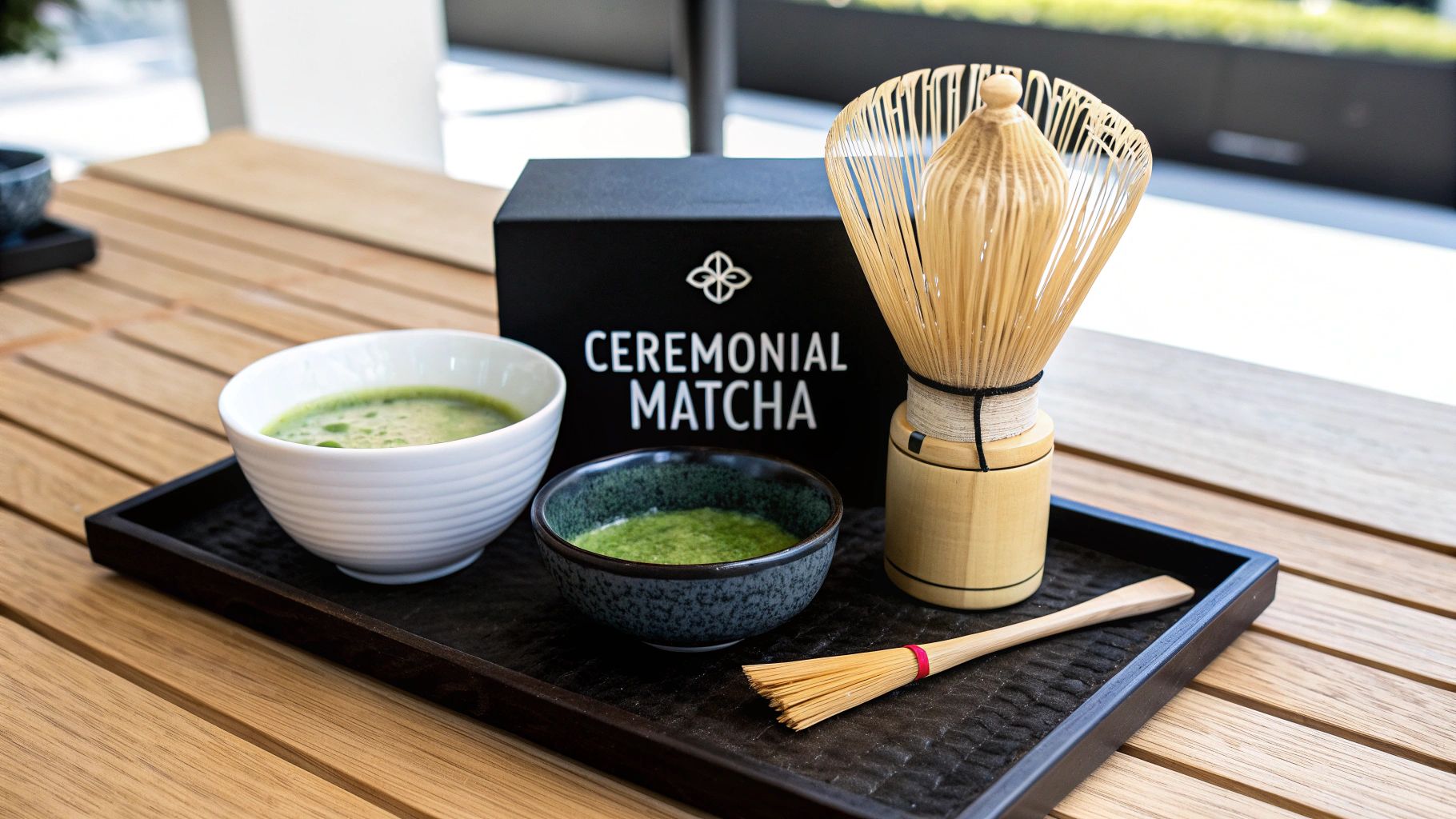
Discover the essential tools in a ceremonial matcha tea set. This guide explains how to choose, use, and care for your set to create the perfect bowl of matcha.
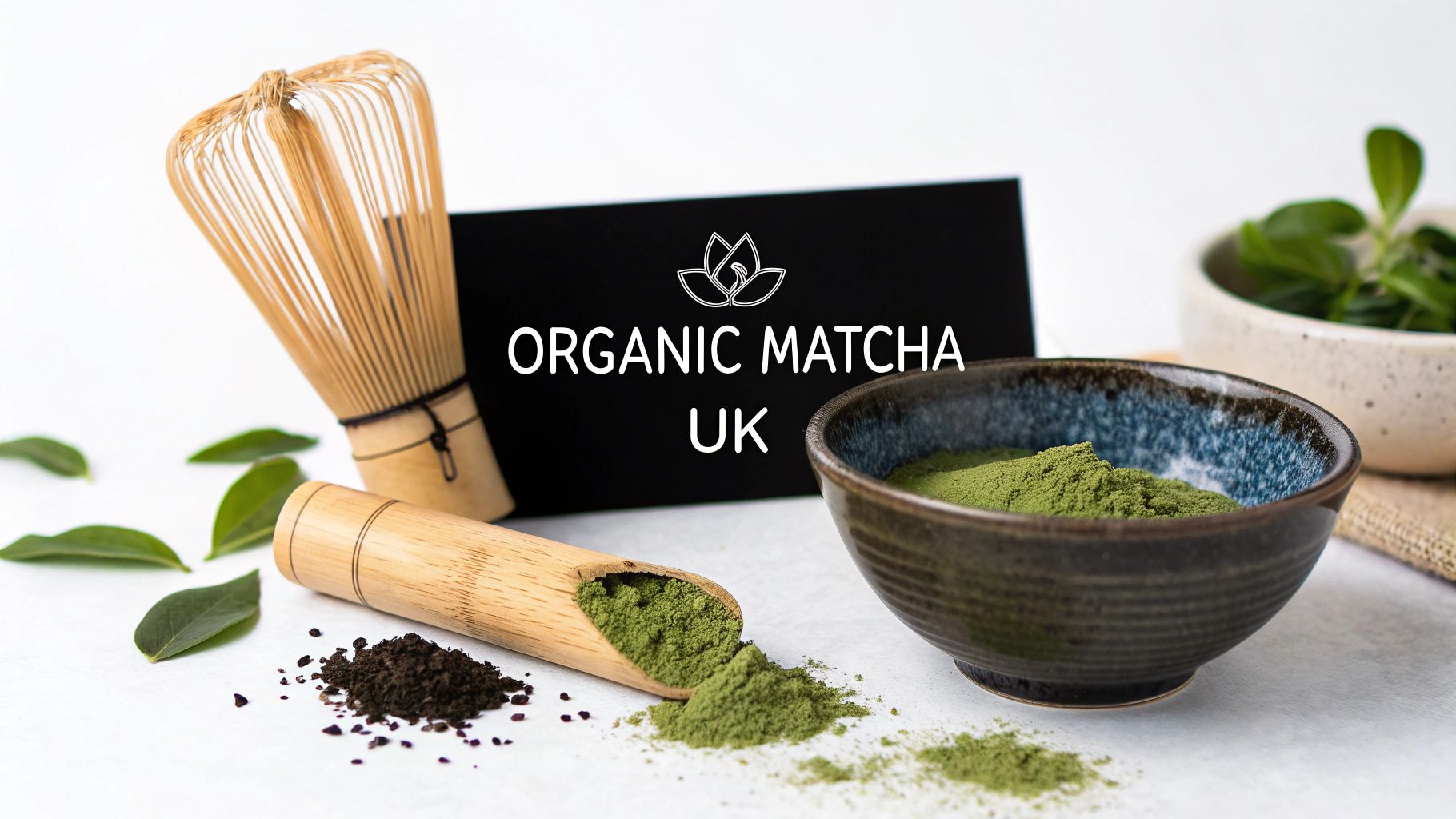
Searching for the best organic matcha powder UK offers? Our guide explains what to look for, its health benefits, and how to prepare the perfect cup.
